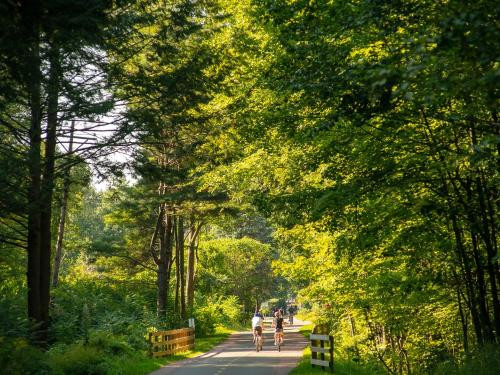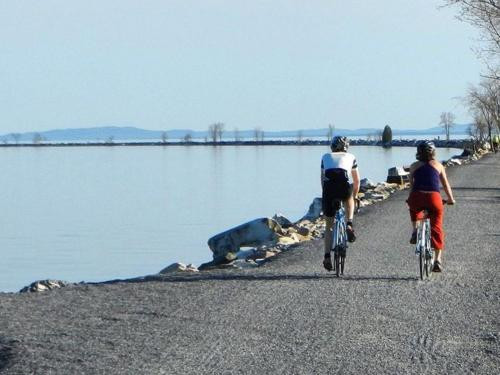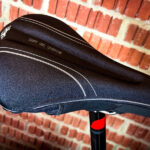It’s easy to see why the Burlington Bike Path holds the coveted title of Trip Advisor’s #1 attraction in Burlington. This beloved route, also known as the Greenway or the Island Line Trail, is a true highlight of Vermont’s Queen City, offering an unparalleled outdoor experience.
The Burlington Bike Trail is a dedicated pedestrian and bicycle pathway tracing the scenic shoreline of Lake Champlain. Cyclists and walkers alike are treated to breathtaking vistas of the expansive lake and the majestic Adirondack Mountains rising across the water in New York. Within Burlington, the well-maintained path stretches for 8.9 miles, seamlessly linking several of the city’s beautiful lakeside parks. These include popular spots like Oakledge Park, North Beach, Leddy Park, and the vibrant Waterfront Park in the heart of downtown Burlington.
 Burlington Bike Path
Burlington Bike Path
The trail itself boasts a generous 12-foot wide paved surface for the majority of its length, accompanied by softer, two-foot-wide running paths on each side. Its close proximity to the lake ensures a relatively flat and easy ride or walk, making it accessible for a wide range of ages and abilities. Crucially, the Burlington Bike Trail is car-free, providing a safe and peaceful environment for leisurely strolls, invigorating jogs, or enjoyable rides on bikes, e-bikes, and even inline skates. This car-free feature is a significant part of its widespread appeal and popularity among both locals and tourists.
The Burlington Bike Path’s origins are rooted in community activism and have played a role in shaping local politics. In 1980, Tom Hudspeth, an environmental studies professor at the University of Vermont (UVM), proposed an innovative idea: transforming an unused railroad corridor in Burlington’s New North End into a dedicated bike path. This vision gained momentum when Rick Sharp, a recent law graduate, and Howard Dean, who would later become Governor of Vermont, joined Hudspeth. Together, they formed the Citizen’s Waterfront Group, advocating passionately for a lakeside bike path downtown. This proposal directly countered plans for the construction of two large condominium towers on the waterfront just north of College Street.
In 1981, the concept of the Burlington Bike Path resonated strongly with the community, securing the support of 75% of Burlington voters in a city ballot initiative. Funding was fully in place by 1984, but the project encountered an unexpected hurdle – a lawsuit that ultimately reached the U.S. Supreme Court. While this legal challenge delayed progress on the Burlington Bike Path for several years, it had a significant positive outcome on a national scale, contributing to the preservation of thousands of miles of former railway lines for the development of rail-trails across the United States. Finally, in 1990, the Burlington Bike Path was completed, stretching continuously from Oakledge Park in the south to the Winooski River in the north, marking a major victory for the community and outdoor enthusiasts.
 Two Bikers on the Burlington Bike Path
Two Bikers on the Burlington Bike Path
Building on the Burlington path’s success, bicycle advocates in Colchester, located across the Winooski River, championed the idea of a bike bridge to connect their town to Burlington’s path. The original railway bridge had been removed in the 1970s. This new bridge would enable the bike path to extend an additional 6 miles onto the historic Colchester Causeway, a 4-mile long former railroad bed extending into Lake Champlain from Colchester Point, ultimately connecting the mainland to the scenic Champlain Islands. However, this ambitious plan faced opposition from residents of the Biscayne Heights subdivision in Colchester. The proposed route required the path to traverse local streets within their neighborhood to reach the Causeway. A small but vocal group of opponents, often referred to as NIMBYs (Not In My Back Yard), resisted the project, even going so far as to suggest using the Winooski River as a barrier to keep out unwanted visitors from Burlington. Their opposition led to the defeat of a ballot measure for the bridge in 1992.
Despite this setback, Colchester’s bicycle advocates remained committed to extending the trail. They focused on the Causeway itself, clearing away overgrown vegetation and revealing a solid cinder bed surface, ideal for cycling. They then proposed a creative solution: a bike ferry to transport cyclists across the Winooski River, providing access to the Causeway. In 1994, Governor Howard Dean, whose political career had been partly launched by the bike path movement, delivered the keynote address at the dedication of the Causeway as a bike trail. Demonstrating his continued support, he allocated $20,000 from the State Transportation budget to fund a bike ferry service. This river bike ferry operated successfully for three seasons, carrying over 40,000 individuals across the river, effectively linking Burlington to the Colchester Causeway and expanding the Burlington bike trail experience.

